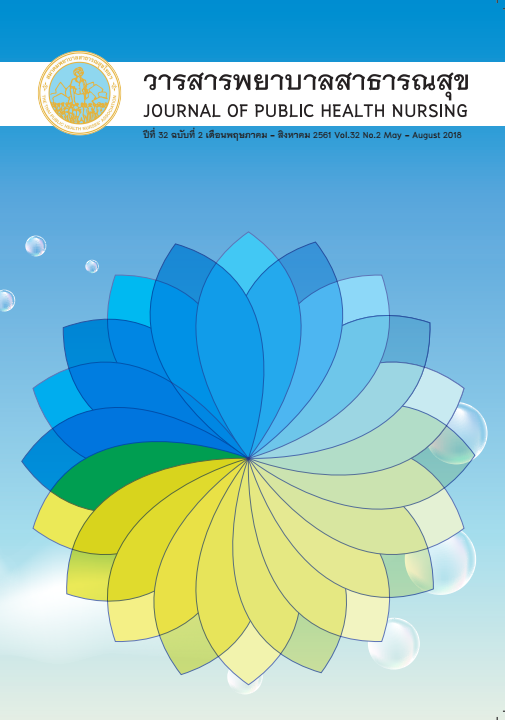Prevalence and Factors Associated with New Students Drinker in Bangkok Metropolitan High Schools
Keywords:
New alcohol consumption, Theory of Planned Behavior, High school studentsAbstract
Alcohol consumption is one of the risk factors leading to premature death and inappropriate sexual behavior. Despite the national policy prohibiting the sale of alcohol to people aged less than 20 years old, the number of new drinkers is likely to continue to increase from 16% presently among Thai youth aged 15 – 19 years old. The sample population of this study consisted of 830 students randomly selected from 10-12th grade students in the Bangkok metropolitan area. Using the Theory of Planned Behavior, data were collected by self-administered questionnaires for Attitude, Subjective Norm, Perceived Behavior, and Intention. Statistical analysis was performed using descriptive statistics entered into the SPSS statistical program. Among this population, there were 246 new drinkers (29.6%) and they each drank approximately one drink per month. The majority of them were boys, and their grade point average (GPA) was at a moderate level. Factors significantly related to the onset of drinking were gender, education, grade point average, other drug use, living patterns, alcohol consumption behavior of family members, family income per month, Perceived Behavior and Intention (p < 0.05). Attitude and Subjective Norm were not significant, but when performing further analysis for subjective norm, friends were found to influence students to become new drinkers. It is recommended that schools organize sessions to inform student attitudes about the Perceived Behavior of alcohol consumption. Student participation in peer group activities could also serve to lessen willingness to exhibit alcohol drinking behaviors. Parents and family members should also provide examples for their children and should consider the negative consequences of drinking alcohol in the family as priority.
References
Center for Alcohol Studies, Facts and Figures: Alcohol in Thailand. Availableat: https://goo.gl/2Hu6wN. July 13, 2017. (in Thai)
National Statistical Office, Report on the alcohol consumption situation and impacts on the country in 2013. Available at: https://www.msociety.go.th/article_attach/11295/15613.pdf. May 10, 2014. (in Thai)
Centers for Disease Control and Prevention. Alcohol and public health [Internet].2007 [cited Available from: https://www.cdc.gov/alcohol/datastas.html
Center for Alcohol Studies, Ministry of Public Health. Report on the alcohol consumption situation and impacts on the country in 2015. Available at: http://resource.thaihealth.or.th/library/hot/15059. May 15, 2016. (in Thai)
Thepnhu J. Factors influencing alcohol drinking among upper secondary school students in Phatthalung Province. [M.Sc.Thesis in Department of Family Health]. Bangkok: Faculty of Graduate studies, Mahidol University, 1997.
Hamchayat A, Yodnil S . Factors related to alcohol drinking among female students in high school Khao Kitchakut district Chantaburi provinc. Journal of Education and Social Development. 2012; 8:115-128. (in Thai)
Bausorn R, Ratchapunnathikul C. Alcohol consumption behavior of Bachelor's Degree students in Bangkok university. Available at: https://www.tcithaijo.org/index.php/RNJ/article/view/8981. January 10, 2013. (in Thai)
Vijitsunthonkul K. Factors influencing alcohol consumption among male vocational students in Bangkok. [M.Sc.Thesis in Health Education and Behavioral Sciences]. Bangkok: Faculty of Graduate studies, Mahidol University,1999.
Ajzen I. The Theory of Planned Behavior. Organization behavior and human decision processes. 1991; 179-211.
Department of Education, Total of Students in 2016. Available at: http://www.bangkok.go.th/bangkokeducation/page/sub/11495/พศ2559. June 10, 2016. (in Thai)
Ngamjarus C, Chongsuvivatwong V. n4Studies: Sample size and power calculations for iOS. The Royal Golden Jubilee Ph.D. Program - The Thailand Research Fund & Prince of Songkla University; 2014. (in Thai)
Kadsigh W. Mean and interpretation. Journal of Educational Research.1995;18:8 11.(in Thai)
Bloom, Benjamin S, James H. Mastery Learning Theory and Practice. New York: Holt, Rinchart and Winston; 1975.
Junaim S. Development psychology (5th ed.). Bangkok: Thaiwattanapanich; 1999.
Sanchez ZM, Martins SS. Social factors associated to binge drinking: a crosssectional survey among Brazilian students in private high schools. Journal of BMC Public Health. 2011.
Phetdum J, Yamkasikorn P, et al. Risk Factors Affecting Deviation Behaviors of Lower Secondary School Students Case Study in Nakhon Nayok Province. Availableat:https://www.mculture.go.th:15005/mocbackend2561/ewt/nakhonnayok/images/R1.pdf. January 10, 2015. (in Thai)
Bandura A. The explanatory and predictive scope of self-efficacy theory. Journal of Clinical and Social Psychology. 1986; 4:359-373.
Powwattana A. Health promotion and disease prevention in communities: application of concepts and theories in practice. Bangkok: Klangnanawithaya. 2011; 162-189. (in Thai)
Center for Alcohol Studies, Ministry of Public Health. Report on the alcohol consumption situation and impacts on the country in 2010. Available at: http://cas.or.th/wpcontent/uploads2015/09annual_report_on_alcohol__2010.pdf. February 10,2015. (in Thai)
Rungprapun C. Basic statistics (5th ed.). Khon Kaen: Faculty of Science Khon Kaen university; 2000. (in Thai)
Ajzen I, Fishbein M. Understanding attitude and predicting social behavior. Englewood Cliffs NJ Prentice Hall; 1980.
Babor T, Higgins J, Saunders J, Monteiro G. The alcohol use disorders identification test: Guidelines for use in primary care (2nd ed.); 2001.
Downloads
Published
How to Cite
Issue
Section
License
บทความที่ตีพิมพ์และแผนภูมิรูปภาพถือเป็นลิขสิทธิ์ของวารสารพยาบาลสาธารณสุข (Thai Public Health Nurses Association)







